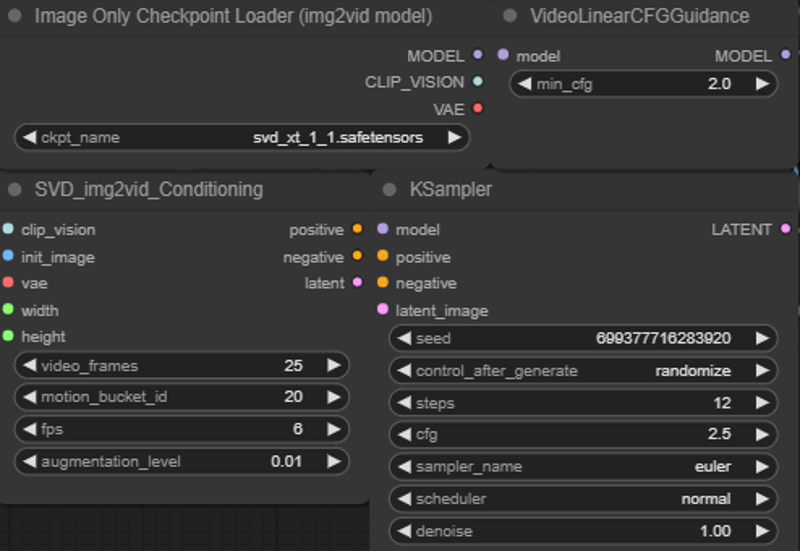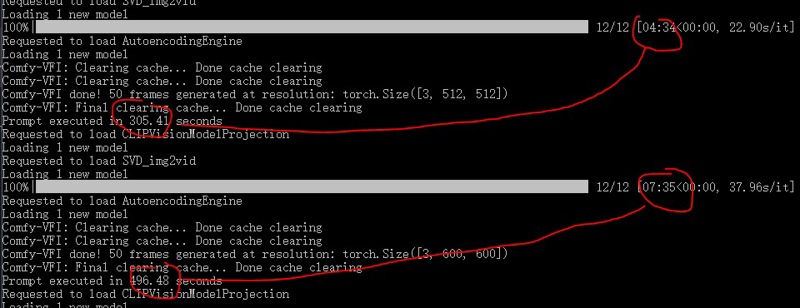Low VRAM Adventures
[🔗link to the series announcement]
ComfyUI Workflow attached!
You will need to download SVD models from huggingface and possibly the rife VFI models.
SVD
Stable Video Diffusion (SVD) is a video generation model provided by StabilityAI.
The research paper mentions text to video, I have not seen it in the wild.
There are two versions :
v1.0 released in November 2023.
v1.1 released in February 2024.
SVD is an image to video model that only takes one image as input and does not expose precise generative controls. SVD generates a fixed number of frames, there are two SVD 1.0 models, generating 14 (regular) and 25 frames (XT) respectively, SVD 1.1 only exists as XT model. 25 frames equal to about 4 seconds of video.

SVD offer limited controls to the user:
width and height, or output video size
augmentation_level or how much it will modify the source image
motion_bucket_id. The name can be misleading, you are not able to select a precise animation (like panning, zooming,...), but it will animate more with a higher value.
StabilityAI claims generations to be less than 2 minutes.
How does it perform on Low VRAM systems?
Let's find out!
Test setup
Unless specified, data comes from generations on the system described in the announcement article.
i58400
16G RAM 2133Mhz
Nvidia GTX1060 6G
Windows 10 64bits
ComfyUI Portable + run_nvidia_gpu
Cuda 12
Test MO
I only run tests on the XT / 25 frames models
constant motion_bucket_id
constant augmentation_level
contant frames and fps
constant sampler values except for the seed (forgot…)
constant video cfg
variable resolution (constrained on the large side)
480px
512px
600px
768px
1024px
I record ComfyUI self reported times

For this article I did not run 100s of generations. I have used SVD for months already and I know that its render times are very consistent for a given resolution. It does occasionally have a first generation much slower than the rest of a batch, but I would exclude those data points.
I have run the smaller resolutions up to 20 times (480-768) and the bigger once or twice.
It would take days just to run the bigger generations 10x times.
Welcome to the Low VRAM world!
Results
Generation Times (on 1060 6Gb)
SVD 1.0 XT
| Long Side (pixels) | Time |
| | wide* | square |
|——————————————————————+———————————+————————————|
| 480 | 2m 10s | 4m 00s |
| 512 | 2m 30s | 4m 50s |
| 600 | 3m 30s | 7m 30s |
| 768 | 6m 30s | 25m |
| 1024 | 25m | 105m |
* wide: proportional to the native 1024×576 resolution.SVD 1.1
| Long Side (pixels) | Time |
| | wide* | square |
|——————————————————————+———————————+————————————|
| 480 | 2m 20s | 4m 00s |
| 512 | 2m 30s | 4m 30s |
| 600 | 3m 30s | 7m 30s |
| 768 | 7m | 25m |
| 1024 | 29m | 120m |
* wide: proportional to the native 1024×576 resolution.Interpretation
Essentially, render time is identical.
Only the 1024px wide side generations show significant difference. This can be due to the small dataset. I'm not running 1000~1200 minutes of render to test 5 times each.
We can also tell that render time grows exponentially with the size.
Render quality
Unsurprisingly 480 and 512 renders have no apparent difference in quality and very little render time difference.
For "fast" square generations, I would recommend 512.
600, 768 and 1024 all show significant quality improvements to lower resolutions.
Due to the random nature of animations and high risk of a completely blurry output, I would not want to use any generations running longer than 10 minutes.
Sample
I'll be honest. I do not think that my source images are very good to compare SVD 1.0 and 1.1 outputs. In retrospect I should have gone with common scenes, such as a car on a road or a train or a cat.
See for yourself:
SVD 1.0 XT Square generations: https://civitai.com/posts/1560464
SVD 1.0 XT Wide generations: https://civitai.com/posts/1560500
SVD 1.1 Square generations: https://civitai.com/posts/1560414
SVD 1.1 Wide generations: https://civitai.com/posts/1560440


